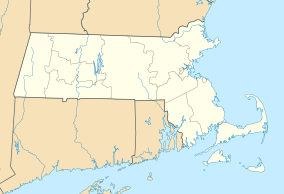Quincy Quarries Reservation facts for kids
Quick facts for kids Quincy Quarries Reservation |
|
|---|---|

View across earth-filled quarry
|
|
| Location | Quincy, Norfolk, Massachusetts, United States |
| Area | 22 acres (8.9 ha) |
| Established | 1985 |
| Operator | Massachusetts Department of Conservation and Recreation |
| Website | Quincy Quarries |
The Quincy Quarries are a cool place in Quincy, Massachusetts. For over 100 years, people dug up granite stone here. This place was also home to the Granite Railway. Many people say this was the first railroad in the United States! Today, about 22 acres of the old quarries are a public park. The Massachusetts Department of Conservation and Recreation takes care of it.
Contents
History of the Quarries
In 1825, a man named Solomon Willard was looking for stone. He needed a lot of stone for the Bunker Hill Monument. This monument was being built in Charlestown. After looking all over New England, he chose the Quincy site.
Building the Granite Railway
Moving huge granite blocks was very hard. So, on March 4, 1826, a special plan was approved. This plan was to build a railroad. The "Granite Railway" was designed by Gridley Bryant. He was a railway expert. The railway started working on October 7, 1826.
Soon, the granite from these quarries became very famous. People all over the country wanted it. Because of this, stone cutting became the most important job in Quincy.
What Happened After the Quarries Closed?
The last working quarry closed in 1963. After that, the big holes in the ground filled up with water. This water came from rain and underground.
The flooded quarries became a popular spot for cliff jumping. But it was very dangerous. Many people got hurt jumping into the water from high up. The police and the city of Quincy had to figure out what to do.
Quarries Become a Climbing Spot
Around this time, rock climbers also found the quarries. In 1968, a guide for climbing there was published. It was called A Guide to Quincy Quarries. Later, other guidebooks like Boston Rocks also came out. These books helped climbers find the best spots.
In the 1980s, people tried to stop cliff jumping. They put old telephone poles and trees in the water. But these quickly sank a few feet underwater. Jumpers couldn't see them. This made the area even more dangerous.
When the quarries were drained of water, they became a popular place for graffiti artists. They used the rock walls as a giant canvas.
Quincy Quarries Reservation Today
In 1985, the Metropolitan District Commission bought 22 acres of the quarries. This area became the Quincy Quarries Reservation. They finally found a way to make the quarries safer.
A huge highway project in Boston, called the Big Dig, helped. Dirt from the new highway tunnels was brought to Quincy. This dirt was used to fill up the main quarries. This made the area much safer for everyone.
Filling the quarries also opened up new rock sections for climbers. The whole area was improved for public use. Now, the reservation is connected to the Blue Hills Reservation trail system. You can go hiking, rock climbing, and enjoy amazing views of the Boston skyline.


